Millennium development goals, where we are?
Millennium development goals, where we are?
The Millennium Development Goals The Millennium Development Goals (MDGs) are eight international development goals that all United Nations Member States and many international organizations have agreed to achieve by the year 2015.
more(MDGs) represent the commitment of the international community to reduce poverty and hunger significantly and promote development in a relatively short-term period. Although there has been significant progress towards the achievement of the goals, several countries are off track on most MDGs, and in certain Goals, particularly in sub-Saharan Africa, the MDG achievement gap remains relatively large (Table) 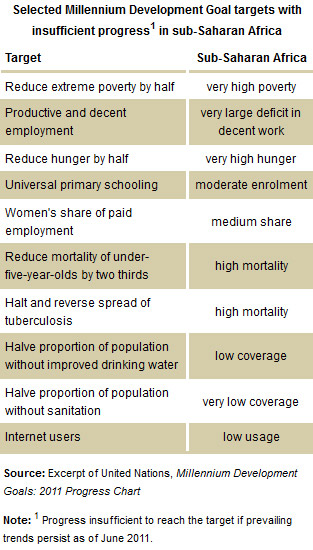 . Around two thirds of developing countries are on track or close to meeting the Goals. Further, the effects of the recent global economic crisis have had a clear negative impact and will make it even more difficult to achieve the MDG by 2015.
. Around two thirds of developing countries are on track or close to meeting the Goals. Further, the effects of the recent global economic crisis have had a clear negative impact and will make it even more difficult to achieve the MDG by 2015.
Proportion of population living on less than $1.25 a day in 2005 and 1990
(Percentage)
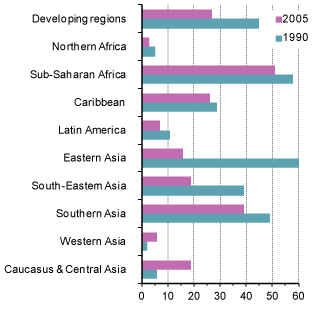
Source: United Nations, MDG Report 2011
Note: The composition of regional groupings follows MDG UN regional classification
The number of people who suffer from hunger remains high in several regions, and in sub-Saharan Africa the level might have increased. Estimates of poverty incidence in sub-Saharan Africa will be 35.8 per cent, essentially the same 36 per cent level achieved before the global economic crisis, and short of the target of 28.8 per cent. In terms of absolute numbers, while 296 million people lived in poverty in the region in 1990, approximately 345 million will be below the extreme poverty line in 2015. Only three low-income countries have currently reached the MDG1 target: Cambodia, Kenya and Mauritania.
Global poverty as a share of total population fell in all regions between 1990 and 2005, with the exception of Caucasus and Central Asia and Western Asia, where levels are very low. It is important to note that the measures are based on a poverty line of $ 1.25 per day, which is considered extreme poverty by the World Bank, and that the results might differ if alternative measures are employed. Most of the progress towards the goal is due to significant reductions in Eastern Asia, while progress in other regions has been less impressive. Latin America and the Caribbean have also progressed significantly towards the goal of halving extreme poverty.
Not only is there significant diversity in the country and regional performance on MDGs achievements, but also there is a high level of variability among different MDGs. While the improvement in gender educational parity has been encouraging, one of the most worrisome developments is represented by the low achievement record in child mortality reduction (Chart) Infant mortality rate in 1990, 2000 and 2009
(Deaths of children before reaching the age of one per 1,000 live births) 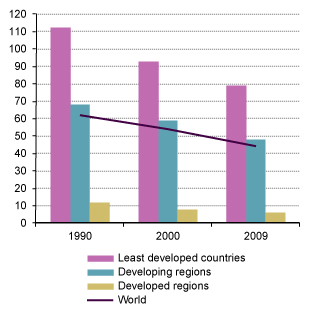 Source: United Nations,MDG Report 2011 Note: The composition of developing and developed regions follows MDG UN regional classification . About 70 per cent of developing countries have achieved or are on track to achieve the targets for gender parity in primary and secondary education. However, only around 36 per cent are on target to reducing the mortality of children under five, mostly from preventable and treatable diseases and conditions, including low dietary energy consumption, unsafe drinking water and the lack of basic sanitation. For example, in the case of sub-Saharan Africa, the target is to reach 61 deaths per 1,000 by 2015, but at the end of 2009, the number was still at 129 per 1,000; according to the World Bank, the region will still be considerably off target by 2030. While still off target with respect to child mortality, most Latin American, Asian and Eastern European countries are considerably closer to the goal.
Source: United Nations,MDG Report 2011 Note: The composition of developing and developed regions follows MDG UN regional classification . About 70 per cent of developing countries have achieved or are on track to achieve the targets for gender parity in primary and secondary education. However, only around 36 per cent are on target to reducing the mortality of children under five, mostly from preventable and treatable diseases and conditions, including low dietary energy consumption, unsafe drinking water and the lack of basic sanitation. For example, in the case of sub-Saharan Africa, the target is to reach 61 deaths per 1,000 by 2015, but at the end of 2009, the number was still at 129 per 1,000; according to the World Bank, the region will still be considerably off target by 2030. While still off target with respect to child mortality, most Latin American, Asian and Eastern European countries are considerably closer to the goal.
Progress made towards Millennium Development Goals in selected indicators by region, 2011
(Indicators)
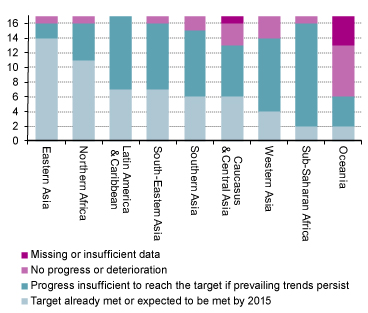
Source: UNCTAD secretariat calculations, based on United Nations, Millennium Development Goals: 2011 Progress Chart
Note: The composition of regional groupings follows MDG UN regional classification
Results are also not particularly promising for maternal mortality reduction, access to sanitation and to a lesser extent, access to clean water and hunger reduction. The percentage of countries on target to achieve the MDGs is uneven by region, and the proportion of developing countries on target to all the goals varies significantly by goal. Unsurprisingly while a significant number of developing countries are on target to achieve the MDGs, sub-Saharan Africa lags in most goals, and only poverty and gender educational parity goals seem to be well within reach.
It is crucial to understand why some regions are lagging significantly behind, and why particular targets seem less amenable to completion. These are important questions that would allow a more rational way forward for policymakers. The two main forces behind the attainment of MDG-related development outcomes are economic growth and the implementation of sound policies and institutions that allow for targeting effective service delivery to the poor. There has been a significant debate and controversy, however, over the relevant policies that are adequate to promote growth, on the one hand, and the advantages of targeting over universalism in the provision of services on the other.
While some authors have emphasized the need for deregulated and liberalized markets with strong property rights in place, with a relatively reduced role for the State, and sound fiscal and monetary policies as the main drivers for growth, the critics have suggested that the global economic crisis has debunked the main tenets of the market-friendly approach to development. Further, some authors have also been critical of the move towards targeting, suggesting that under universalism, the entire population is the beneficiary of social benefits as a basic right. According to this view, since under targeting eligibility to social benefits involves some kind of means-testing to determine the beneficiaries, a question of fairness arises.
Another important issue in the promotion of a more homogenous and widespread achievement of the MDGs is that several of the alternative goals seem to be intertwined (Chart) Proportion of official development assistance provided to help build trade capacity, 2001-2009
(Percentage) 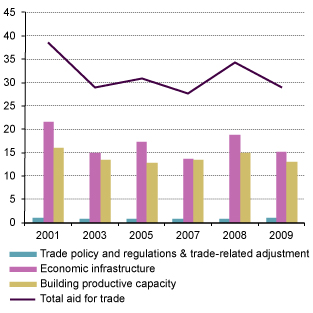 Source: United Nations, MDG Report 2011 , in the sense that it is easier to achieve one specific target if other targets are already on their way to be achieved. For example, it might be easier to reduce child mortality if access to clean water, access to sanitation and reduced hunger are already dealt with. In order to achieve the MDGs, an emphasis on growth is relevant but it is essential to tackle the issue of income distribution.
Source: United Nations, MDG Report 2011 , in the sense that it is easier to achieve one specific target if other targets are already on their way to be achieved. For example, it might be easier to reduce child mortality if access to clean water, access to sanitation and reduced hunger are already dealt with. In order to achieve the MDGs, an emphasis on growth is relevant but it is essential to tackle the issue of income distribution.
Highlights
- The percentage of countries on target to achieve the MDGs is uneven by region;
- The proportion of developing countries on target to all the goals varies significantly by goal;
- Global poverty as a share of total population fell in all regions between 1990 and 2005;
- Sub-Saharan Africa lags in most goals;
- Only the poverty and gender educational parity goals seem to be well within reach by 2015;
- There is significant controversy on the best development strategy in order to achieve the MDGs;
- In order to achieve the MDGs, an emphasis on growth is relevant but it is essential to tackle the issue of income distribution.
TO learn more
The Millennium Development Goals Report 2011, United Nations, ST/DPI(058)/M646/2011
UNCTAD Trade and Development Report 2008, Chapter V Official Development Assistance for the MDGs and Economic Growth, UNCTAD/TDR/2008
Empowering MDG Strategies through Inclusive Economic Development, TD/B/EX(49)/CRP.2
Reconnecting the Millennium Development Goals to the development agenda: an UNCTAD perspective, TD/B/EX(49)/3
Poverty Reduction and Progress towards MDGs in the LDCs: Encouraging signs but much remains to be done, UNCTAD Policy Briefs, No. 20(e), 10/05/2011
A big public investment push needed in least developed countries to meet Millennium Development Goals, UNCTAD Policy Briefs, No. 16, 20/09/2010
Reconnecting the MDGs to the development agenda: A four-pronged approach, UNCTAD Policy Briefs, No. 14, 16/06/2010
Improving the Odds of Achieving the MDGs, Global Monitoring Report 2011, 2011 The International Bank for Reconstruction and Development / The World Bank, ISBN: 978-0-8213-8700-9
